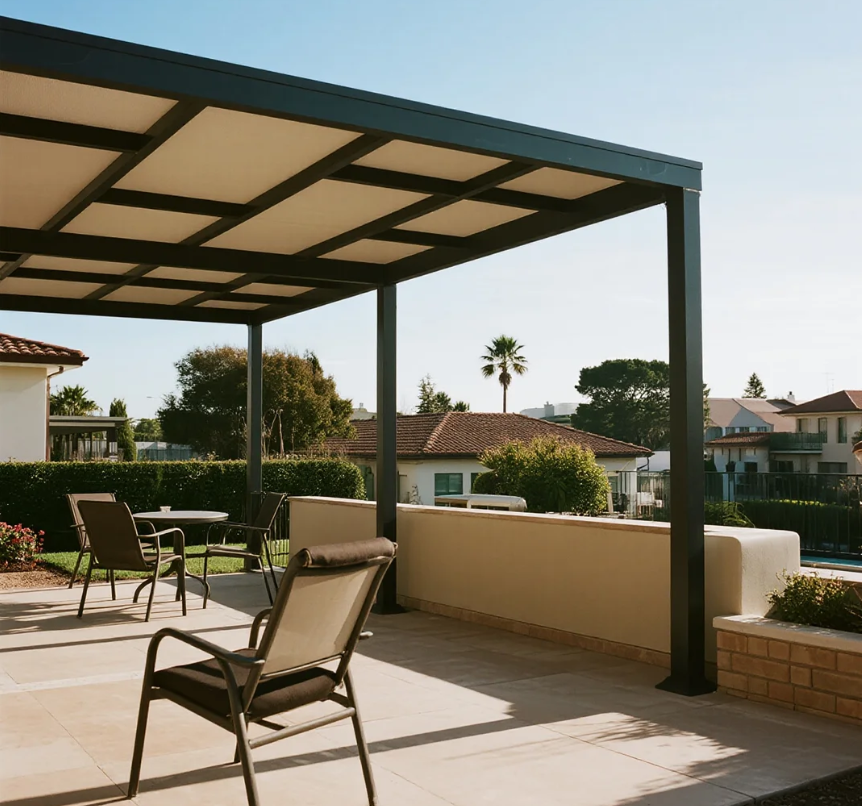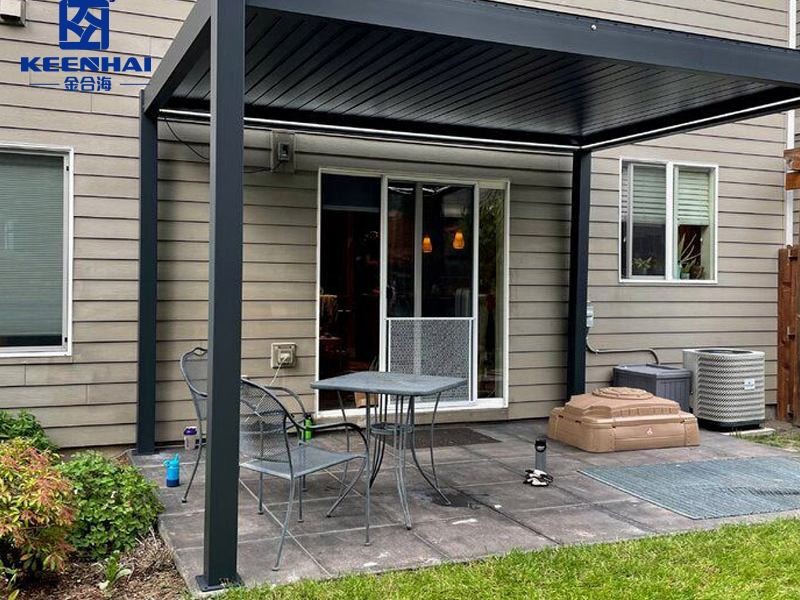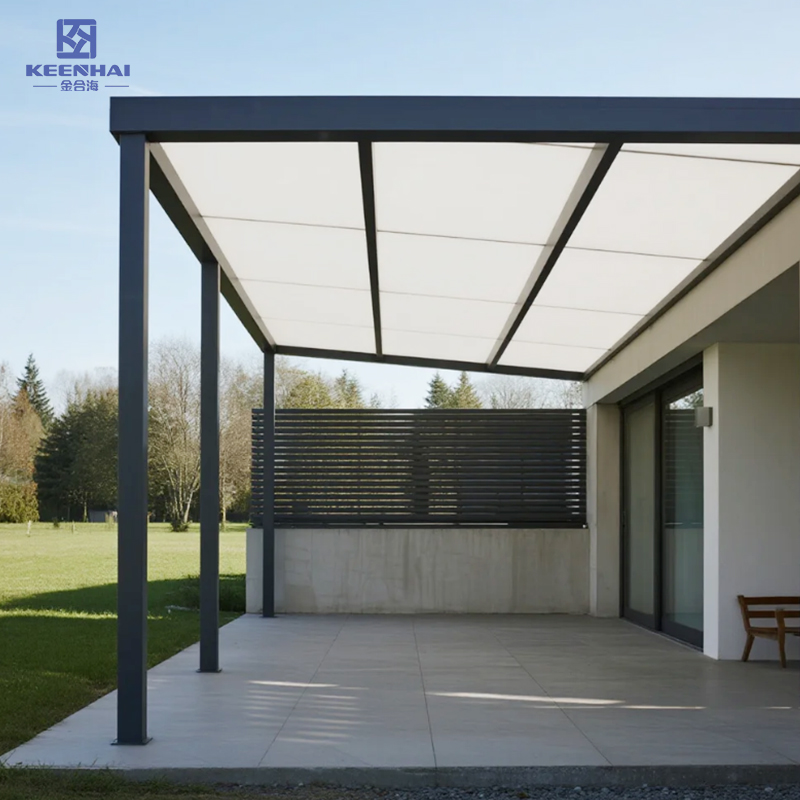
1. Material Characteristics
1.1 Aluminium Pergola Properties
1.1.1 Durability and Weather Resistance
Aluminium pergolas are known for their exceptional resistance to weather. Unlike wood, they don’t warp, crack, or rot over time, even under intense sun or heavy rain. In coastal areas, where saltwater exposure can be an issue, aluminium frames maintain their structure without rusting, making them a popular choice for beachfront patios. You can often see aluminium pergolas used in modern restaurants and rooftop gardens in cities like Miami and Barcelona, where durability under high humidity is essential.
1.1.2 Maintenance Requirements
Maintenance for aluminium is straightforward. Occasional cleaning with mild soap and water is enough to keep the surface looking new. No staining, sealing, or sanding is required, which is ideal for busy homeowners. Many commercial properties with high foot traffic prefer aluminium because it keeps its finish with minimal effort, allowing maintenance teams to focus on other tasks.
1.2 Wood Pergola Properties
1.2.1 Types of Wood and Grain Patterns
Wood pergolas bring a natural warmth that aluminium cannot match. Popular wood choices include cedar, redwood, and teak, each offering unique grain patterns and colors. Cedar, for example, has a rich reddish-brown hue and aromatic scent, often used in backyard garden setups or private pool areas. Teak is highly resistant to moisture and insect damage, making it suitable for outdoor decks in tropical climates.
1.2.2 Natural Aging and Care
Wood changes over time, which can be a benefit if you enjoy the look of natural weathering. Exposure to sunlight gradually shifts the color to a silver-grey, adding character to outdoor spaces. However, wood requires proactive maintenance:
-
Inspect the structure every 6–12 months for cracks, rot, or insect damage.
-
Apply a protective sealant or stain annually to maintain water resistance and color.
-
Clean the surface gently with a soft brush to remove dirt and mold.
This care routine is common in luxury residential projects, such as private gardens in California or outdoor patios in European villas, where the natural look enhances aesthetic appeal while ensuring longevity.
1.3 Aluminium vs Wood: Material Comparison
| Feature | Aluminium | Wood |
|---|---|---|
| Weather Resistance | Excellent, rust-proof | Moderate, can warp or rot |
| Maintenance | Low, simple cleaning | High, requires staining/sealing |
| Lifespan | 20–30 years | 10–25 years depending on wood type |
| Aesthetic Appeal | Modern, sleek | Natural, warm, traditional |
| Weight | Lightweight | Heavier, may need stronger foundation |
This table helps homeowners quickly compare which material fits their climate, maintenance willingness, and design goals. For example, in a rainy Pacific Northwest backyard, aluminium reduces the risk of rot, while in a sun-drenched backyard in Tuscany, cedar wood can create a classic, inviting look.

2. Aesthetic Considerations
2.1 Matching Your Garden or Outdoor Space
When choosing between aluminium and wood pergolas, the first thing to consider is how it fits your existing outdoor space. Aluminium’s sleek lines and minimalist design work perfectly with modern homes, rooftop terraces, and urban patios. Picture a rooftop lounge in New York City with an aluminium pergola paired with steel-framed furniture and glass panels—it feels open and contemporary. Wood, on the other hand, blends naturally with greenery, stone pathways, and rustic landscapes. Think of a backyard in the English countryside with a cedar pergola surrounded by climbing roses—it creates a cozy, organic atmosphere.
2.2 Color Options and Finishes
Aluminium pergolas come in a wide range of powder-coated finishes, from matte black to soft beige, which stay vibrant for years without fading. You can match the frame to window frames, outdoor furniture, or even your pool tiles. Wood pergolas offer natural tones, but they can also be painted or stained. Dark walnut or teak stain can elevate a classic backyard, while lighter pine shades maintain a casual, airy feel.
| Feature | Aluminium | Wood |
|---|---|---|
| Color Variety | Wide, stable, fade-resistant | Limited natural shades, customizable with stains or paint |
| Finish Durability | Lasts 10+ years without fading | Needs annual maintenance to retain color |
| Visual Style | Modern, minimalist | Warm, rustic, natural |
This comparison is useful for homeowners deciding whether their outdoor space should feel modern and sleek or warm and inviting. For example, a Mediterranean-style patio often looks best with wood, while a contemporary city rooftop is enhanced by aluminium.
2.3 Customization Possibilities
Both materials allow for customization, but in different ways. Aluminium can be fabricated into precise shapes, adjustable louvered roofs, or integrated lighting systems, which is common in luxury hotel terraces or poolside bars. Wood is easier to carve or shape for intricate designs like lattice panels, curved beams, or pergolas with climbing plants. In a backyard garden in Barcelona, you might see a wood pergola carefully carved to frame a jasmine vine, creating a natural, fragrant canopy. In contrast, an aluminium pergola on a rooftop in Dubai might include automated retractable louvers for sun control, giving it a high-tech touch.

3. Cost and Budget
3.1 Initial Purchase Price Comparison
The upfront cost of a pergola depends heavily on the material and size. Aluminium pergolas generally start higher due to the manufacturing process and powder-coated finish, but they offer consistent quality and long-term durability. For example, a 12x12 ft aluminium pergola in a Miami rooftop terrace can cost around $3,500–$5,000, including standard installation. Wood pergolas can be cheaper initially, with cedar or pine starting at $2,000–$3,000 for a similar size, but high-quality teak or redwood can exceed aluminium prices. Many homeowners in suburban areas of California choose cedar for its natural look while balancing cost and visual appeal.
3.2 Long-Term Maintenance Costs
Maintenance costs are where the difference becomes significant. Aluminium requires minimal upkeep—washing it a few times a year is enough, and repainting is rarely needed. Wood, however, needs more attention:
-
Inspect for rot, cracks, or insect damage every 6–12 months.
-
Re-stain or seal the surface annually, costing $150–$300 for a standard backyard pergola.
-
Occasional repairs to warped or damaged panels can add $200–$500 over time.
This explains why commercial properties, like restaurants or hotels with high-traffic patios, often prefer aluminium—it reduces both labor and material costs over time.
3.3 Value Retention Over Time
| Feature | Aluminium | Wood |
|---|---|---|
| Initial Cost | High, $3,500–$5,000 | Moderate, $2,000–$4,000 |
| Annual Maintenance Cost | Low, $0–$50 | Moderate–High, $150–$300 |
| Lifespan | 20–30 years | 10–25 years depending on wood |
| Resale / Property Impact | Stable, looks modern | Can enhance natural aesthetic |
Aluminium tends to retain value because it looks new and resists weathering, which appeals to buyers in urban areas. Wood adds charm, especially in suburban or rural settings, but its resale appeal depends on condition and upkeep. For instance, a cedar pergola in a renovated garden in Boston can increase the aesthetic value of the property, but if the wood is weathered and untreated, it may detract from the appeal.

4. Installation and Flexibility
4.1 Ease of Assembly
Aluminium pergolas are generally easier and faster to assemble because they come in pre-fabricated panels and lightweight frames. Typical installation steps include:
-
Measure and mark the installation area precisely.
-
Prepare the foundation—either concrete footings or adjustable base plates.
-
Assemble the frame according to manufacturer instructions, usually with bolts and brackets.
-
Attach roof panels, either fixed or adjustable louvers, ensuring level alignment.
Many urban rooftop projects, like terraces in Los Angeles or Barcelona, use aluminium pergolas because crews can install them in one day, reducing labor costs and disruption. Wood pergolas often require more on-site carpentry, including cutting, sanding, and securing heavy beams, which can extend installation to several days, especially for custom designs.
4.2 Modularity and Expansion Options
Aluminium pergolas offer high flexibility for modular designs. Sections can be added or removed easily, and features like retractable roofs, LED lighting, or integrated gutters can be incorporated without compromising structure. For instance, a restaurant in Miami extended its aluminium pergola by 6 ft to accommodate extra outdoor seating, with minimal disruption.
Wood pergolas can also be expanded, but the process is more labor-intensive. Adding sections typically requires matching wood type, cutting new beams to size, and refinishing surfaces to blend with existing structures.
4.3 Weight and Structural Support Requirements
| Feature | Aluminium Pergola | Wood Pergola |
|---|---|---|
| Weight | Lightweight, easier to handle | Heavy, requires strong foundation |
| Roof Options | Louvered, retractable, fixed | Fixed, limited louver options |
| Installation Crew | 2–3 people for standard size | 3–5 people for large or custom |
| Expansion / Modification | Simple modular add-ons | Requires carpentry skills |
Aluminium’s lighter weight allows installation on rooftop terraces or older decks without overloading structures, whereas wood often needs reinforced foundations, especially in windy or snowy regions. For example, cedar pergolas installed in Denver must be anchored to reinforced footings to withstand heavy snow loads, while aluminium units handle the same conditions with standard anchors.
